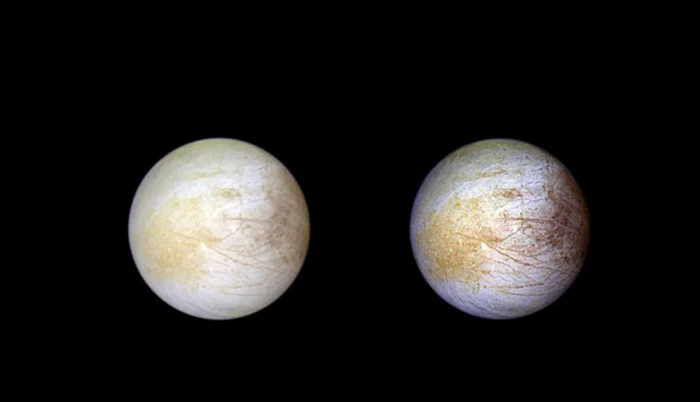![]() Home > Space & Science
Home > Space & Science
NASA's James Webb Telescope may have found the source of Europa's carbon

NASA/JPL/University of Arizona
![]() September 23rd, 2023 | 12:32 PM |
September 23rd, 2023 | 12:32 PM | ![]() 1488 views
1488 views
SPACE
Scientists believe carbon dioxide on the moon came from its subsurface ocean.
Before the Galileo spacecraft was destroyed two decades ago, it detected several chemicals on the surface of Jupiter's moon Europa, including carbon dioxide. Now, a couple of studies using observations by the James Webb Space Telescope (JWST) suggest that the carbon dioxide on Europa's surface came from the ocean hidden underneath its icy shell. Further, the researchers have come to the conclusion that it's pretty recent in origin — geologically speaking, at least.
The observations made using the telescope's Near-Infrared Spectrograph (NIRSpec) instrument showed scientists that the carbon dioxide on Europa is most abundant in an area called Tara Regio, or "chaos terrain." In the images above, you'll see Tara Regio as the yellowish area to the left of the moon's center.
Emily Martin, a planetary geologist at the National Air and Space Museum, told Scientific American that scientists believe Tara Regio's ice surface broke up when the weather got warm enough at one point. That caused the water from the subsurface ocean to come up, until it got cold again to create a slushy icy water sort of area. It's worth noting that previous Hubble observations of the region show that it also contains table salt, which indicates that saltwater, indeed, could've risen up to the surface of the moon.
If Europa's carbon dioxide truly did come from its ocean instead of from meteors or other sources, then it would establish a big similarity between our planet and the moon. Europa is one of the objects in our solar system that's under observation for potentially having the conditions to support life. In April this year, the European Space Agency launched the Jupiter Icy Moons Explorer or JUICE to make detailed observations of the planet's ocean-bearing moons Ganymede, Callisto and Europa. Meanwhile, NASA's Europa Clipper spacecraft, which will focus on the potential for life in the moon's ocean, is scheduled to take off sometime next year.
Source:
courtesy of ENGADGET
by Mariella Moon , Contributing Reporter
If you have any stories or news that you would like to share with the global online community, please feel free to share it with us by contacting us directly at [email protected]